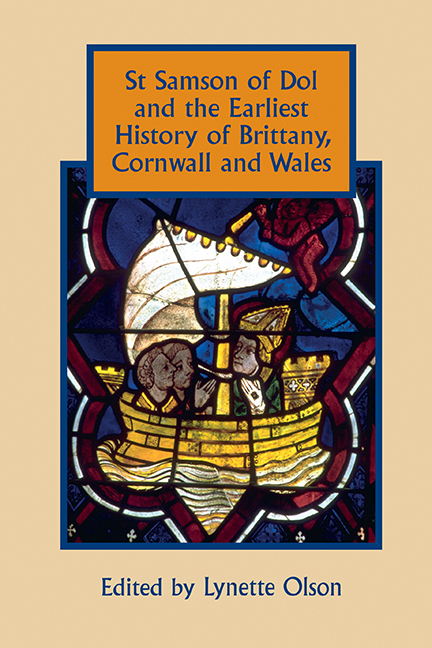Book contents
- Frontmatter
- Contents
- List of Tables
- Editor's Preface
- Map: Places associated with St Samson in the First Life
- 1 Introduction: ‘Getting Somewhere’ with the First Life of St Samson of Dol
- 2 A Family and its Saint in the Vita Prima Samsonis
- 3 La Circulation de l'information dans la Vie ancienne de s. Samson de Dol et la question de sa datation
- 4 The Hare and the Tortoise? Vita Prima Sancti Samsonis, Vita Paterni, and Merovingian Hagiography
- 5 Columbanus, the Britons, and the Merovingian Church
- 6 Apostolic Authority and Celtic Liturgies: from the Vita Samsonis to the Ratio de cursus
- 7 The Representation of Early British Monasticism and Peregrinatio in Vita Prima S. Samsonis
- 8 Present and Yet Absent: the Cult of St Samson of Dol in Wales
- Bibliography
- Index
- Studies in Celtic History
7 - The Representation of Early British Monasticism and Peregrinatio in Vita Prima S. Samsonis
Published online by Cambridge University Press: 05 July 2018
- Frontmatter
- Contents
- List of Tables
- Editor's Preface
- Map: Places associated with St Samson in the First Life
- 1 Introduction: ‘Getting Somewhere’ with the First Life of St Samson of Dol
- 2 A Family and its Saint in the Vita Prima Samsonis
- 3 La Circulation de l'information dans la Vie ancienne de s. Samson de Dol et la question de sa datation
- 4 The Hare and the Tortoise? Vita Prima Sancti Samsonis, Vita Paterni, and Merovingian Hagiography
- 5 Columbanus, the Britons, and the Merovingian Church
- 6 Apostolic Authority and Celtic Liturgies: from the Vita Samsonis to the Ratio de cursus
- 7 The Representation of Early British Monasticism and Peregrinatio in Vita Prima S. Samsonis
- 8 Present and Yet Absent: the Cult of St Samson of Dol in Wales
- Bibliography
- Index
- Studies in Celtic History
Summary
Vita Prima Sancti Samsonis is a text of great interest for writing the early history of the Church in Celtic Britain. It appears to be dateable to before the advent (probably in the eighth century) of contemporary records in the Welsh chronicles and to be earlier than any extant British Lives of saints; it is also, clearly, witness to older hagiographical records from Britain that are now lost. The text of the Vita Prima (hereafter VIS) having been transmitted on the Continent, its contents – and by extension older sources it may incorporate – existed independently of revisions of Welsh ecclesiastical sources that occurred in the early second millennium AD. VIS can hence act as a window on an obscure but formative period of Welsh Church history. Its anonymous author (hereafter the ‘Samson-author’), unusually among Continental hagiographers of Insular saints, was inspired to retrace personally his subject's journey back across the sea, providing us with a series of detailed descriptions of life at monasteries in different parts of Britain. In VIS he sets out a narrative of the progression of a monk into, ultimately, self-exile (peregrinatio) from his own country – a practice rarely identified with the early British Church. The detail is sometimes remarkable. There are vivid glimpses into processes of memory concerning early holy men, as well as description of sensory experiences such as listening to texts (Prol.2, I.1, I.42) and physical detail of how saints were reverenced at individual places (I.41, I.48). Although it is often challenging to interpret, there can be no doubt as to the great value of VIS as a source. Indeed, it may even be that its unusual character sometimes inspires us to ask the wrong questions and find ambiguity where clarity is actually to be found.
My focus in the following discussion will be primarily upon the witness of VIS to monasticism.
- Type
- Chapter
- Information
- Publisher: Boydell & BrewerPrint publication year: 2018



